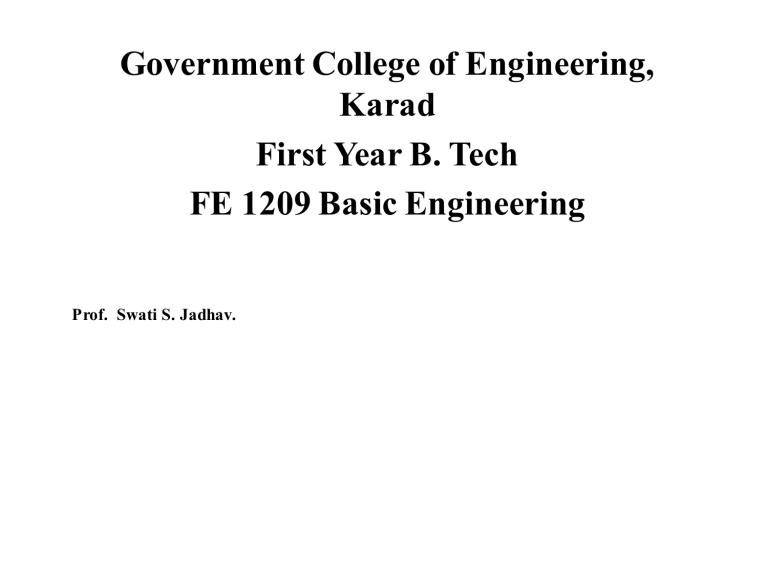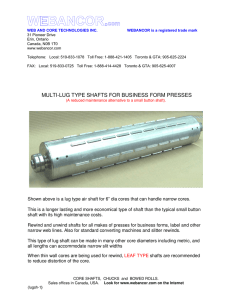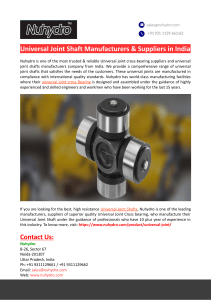
Government College of Engineering, Karad First Year B. Tech FE 1209 Basic Engineering Prof. Swati S. Jadhav. Content • Manufacturing Processes: Turning, milling, drilling. • Material properties, tensile, compressive and shear strength, ductility, malleability, hardness. • Mechanical Power Transmission: Machine elements: Axle, shaft, keys, pulleys, etc. Belt drives, gear drives, chain drives, Applications of these devices (Numerical treatment on Torque, speed, power for belt and gear drive only) • What is manufacturing? “act of making something (a product) from raw materials” Manufacturing Processes • Two basic types: • 1.Processing operations- transform a work material from one state of completion to a more advanced state–Operations that change the geometry, properties, –Operations that change the geometry, properties, or appearance of the starting material • 2.Assembly operations - join two or more components to create a new entity Classification of manufacturing processes Processing Operations Three categories of processing operations: 1.Shaping operations - alter the geometry of the starting work material 2.Property-enhancing operations - improve physical properties without changing shape 3.Surface processing operations - to clean, treat, coat, or deposit material on exterior surface of the work Shaping Processes – Four Categories • Solidification processes - starting material is a heated liquid or semifluid • Particulate processing - starting material consists of powders • Deformation processes - starting material is a ductile solid (commonly metal) • Material removal processes - starting material is a ductile or brittle solid Solidification Processes Starting material is heated sufficiently to transform it into a liquid or highly plastic state • Examples: metal casting, plastic molding Particulate Processing Starting materials are powders of metals or ceramics Usually involves pressing and sintering, in which powders are first compressed and then heated to bond the individual particles Steps: Pressing and sintering Deformation Processes Starting workpart is shaped by application of forces that exceed the yield strength of the material • Examples: (a) forging, (b) extrusion Material Removal Processes Excess material removed from the starting piece so what remains is the desired geometry • Examples: machining such as turning, drilling, and milling; also grinding and nontraditional processes TURNING DRILLING MILLING OPERATION According to Newton's third law, the cylinder will experience a force downward on the lower surface of the cylinder and an equal and opposite force on the upper surface of the cylinder. My cylinder has an original length of Io and surface area of Ao. As I pull on my material with the force F the cylinder will lengthen and the resulting length will be l. Stress, σ, is defined as the force divided by the initial surface area, σ=F/Ao. This pulling stress is called tensile stress. Strain is what results from this stress. Strain, ε, is defined as the change in length divided by the original length, ε=ΔI/Io. Before we proceed further with stress and strain, let's define some other types of stress. If instead of pulling on our material, we push or compress our cylinder we are introducing compressive stress. This is illustrated in the following figure: If instead of applying a force perpendicular to the surface, we apply parallel but opposite forces on the two surfaces we are applying a shear stress. This is illustrated in the following figure: Stress related to shear is torsional stress. If we hold one end of our cylinder fixed and twist the other end as shown in the figure below, we are applying a torsional (or twisting) stress. • DUCTILITY: It is a measure of the amount of deformation of a material can withstand before breaking. It is also the ability of a material by which it can be drawn into wires. • MALLEABILITY: It is the ability of a material by which it can be rolled into sheets. Malleability is the ability of a material to exhibit large deformation subjected to compressive force whereas ductility is the ability of a material to deform upon the application of tensile force. Aluminium, Copper and gold have good malleability. • HARDNESS: It is the ability of a material to offer resistance to penetration or indentation. It is also the ability to resist wear, abrasion, scratch or cutting. Mechanical Power Transmission What is Machine? Machine is a device consisting of various elements arranged together, so as to perform the prescribe task to satisfy human needs. Machine Elements •Machine element is an individual component or a group of components of a machine which performs a specific function. •Its function may be of holding the components together, to transmit power or to give supports. •Depending upon these functions only, the machine elements are following types. 1) Machine elements used for holding the components. 2) Machine elements used for transmitting the power. 3) Machine elements used for support of other components. Shaft Types of shafts Axles •It is non-rotating machine element which is used to support rotating machine elements like : wheels, pulleys etc. Types of Shafts A ) Machine shaft:These shafts form an integral part of the machine itself. e.g. crank shaft of an I.C. engine . 1) Axle An axle is stationary shaft i.e. Non rotating member, which supports a rotating element like wheel or hoisting drum and fitted to the housing by means of bearings. Axle is subjected to bending load only and does not transmit any useful torque. e.g. • rear axle of railway wagon • axle of motor car • supporting wheels. 2) Spindle: A spindle is a short rotating shaft. Spindles are used in all machine tools to give motion to a cutting tool or to a work piece. e.g. • spindle of drilling machine. • drive shaft of lathe. B) Transmission shaft: These shafts transmit power from the source of power to the machine which absorbs that power. e.g. the power is transmitted from motor to compressor by means of a transmission shaft. The transmission shaft is usually circular in cross section. The shaft is always stepped (having different cross sections of shafts) for positioning transmission elements like gears, pulleys and bearings. Transmission shafts may be solid or hollow. Type: 1. main shaft It is a primary shaft, which is driven by the machine shaft and from which the power is supplied to the counter shaft. 2) Countershaft It is a secondary shaft, which is driven by the main shaft and from which the power is supplied to the machine components. Types based on structure of Shafts • Hollow shafts are lighter than solid shafts. They have more strength per kg weight of material compared to solid shaft. • The various types of shafts are as shown in Fig. • The examples of the hollow shafts are propeller shafts. • Main shaft between air compressor and gas turbine in air craft engine. Shaft Material • The material used for the shaft should have the following properties 1) It should have high strength. 2) It should have good machin ability. 3) It should have good heat treatment properties. 4) It should have high wear resistant properties. 5) It should have sufficient hardness. 6) It should be corrosion resistant in marine or corrosive environments. 7) It should have high modulus of elasticity. • The material commonly used for shaft is mild steel. The carbon steel is also used where strength, wear resistance and facility of heat treatment is needed. Keys • A key is a machine element used on shafts to secure the rotating elements like gears, pulleys or sprockets and prevent the relative motion between the two. It is always inserted parallel to the axis of the shaft. Keys are used as temporary fastenings and are subjected to considerable crushing and shearing stresses. A keyway is a slot or recess in a shaft and hub of the pulley to accommodate a key. • Materials used: • Plain carbon steels • Alloy steels • A key performs following two basic functions. 1) The primary function of key is to transmit the torque from the shaft to the hub of machine element and vice-versa. 2) The second function of the key is to prevent relative rotational motion between the shaft and mounted machine element like gear or pulley. • In most of the cases, key also prevents axial motion between the elements. • A keyed joint consisting of shaft, hub and key is illustrated in Fig. • A recess or slot machined on the shaft and or in the hub to accommodate the key is called as key way. • One key way is usually cut by milling machine. • Keys are designed in order to withstand shear and compressive stresses resulting from transmission of torque. • Generally, material of the key is selected, which has less strength than the shaft material. Types of Keys • Keys are broadly classified as a) Saddle keys b) Sunk keys c) Round key d) Splines Keys Belts • The belt drives are of the following types : (a) open belt drive, and (b) cross belt drive. • Open Belt Drive • Cross belt drive • • Let d1 and d2 be the diameters of driving and driven pulleys, respectively. N1 and N2 be the corresponding speeds of driving and driven pulleys, respectively. The velocity of the belt passing over the driver • If there is no slip between the belt and pulley • If thickness of the belt is ‘t’, and it is not negligible in comparison to the diameter, • Let there be total percentage slip ‘S’ in the belt drive which can be taken into account as follows : Chain Gears


